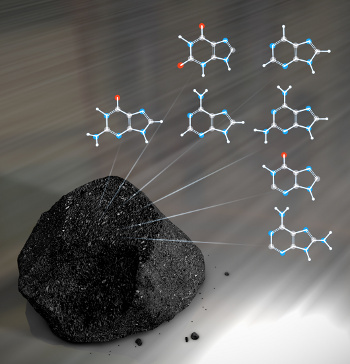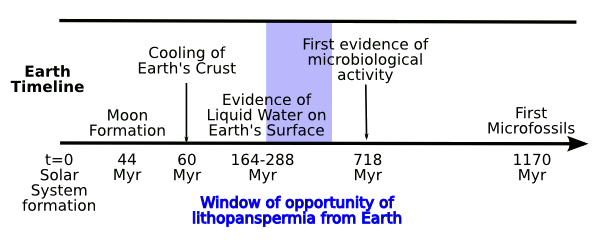Life from Space
October 12, 2012
There's nothing like a good dose of
heat to
sterilize an object. After the
Earth was formed and passed through the aptly named
Hadean period, it was definitely a sterile environment. After a very short time,
geologically speaking,
life appeared on the Earth and quickly blossomed to fill every
ecological niche.
Scientists have not yet pinned down the course of Earth's
abiogenesis; perhaps, this will never be possible. That doesn't stop
speculation as to what steps may have been involved.
Panspermia is the
hypothesis that life on Earth was actually seeded by life elsewhere. Panspermia is not an attractive theory for those looking for an ultimate origin story, since it just pushes the question of abiogenesis back to another level. However, it would be a very easy way to explain life on Earth.
Panspermia doesn't need to consist only of the process in which a
spore of an
organism somehow survived a very long journey in
space, a plunge through
Earth's atmosphere, and a
hard landing on Earth.
Meteorites rich in
organic compounds could have been just the spark needed to start the
genesis of life on Earth. It's easier to cook with the right ingredients.
Carbonaceous chondrites are a class of
meteorites containing
water and
organic compounds. These are remnants of the original
condensation of the
Solar System. Along with
amino acids, some complex organic molecules have been found in such meteorites. These include
keto acids, such as
pyruvic acid, hydroxy tricarboxylic acids, such as
citric acid, and
tricarboxylic acids.[1] Since some of these compounds are
labile, a steady influx of these from space would have aided abiogenesis.[1]
Nucleobases, essential components of
DNA and
RNA, have been detected in meteorites since the 1960's, but it was not possible to exclude terrestrial contamination.[2] However, recent studies have found nucleobases that are uncommon on Earth, and the nucleobase distributions do not mimic those in the environment of the meteorite fall. This is especially apparent in meteorites recovered from the generally sterile
Antarctic environment. A
NASA-lead research team has found the DNA nucleobases,
adenine and
guanine, along with the less common
hypoxanthine and
xanthine, in meteorites.[2-5]

(Image: NASA's Goddard Space Flight Center/Chris Smith))
The research team had members from NASA's
Goddard Space Flight Center and the
Goddard Center for Astrobiology (
Greenbelt, MD),
Pennsylvania State University, the
Carnegie Institution of Washington and
Thermo Fisher Scientific (
Somerset, NJ). One chemical discovered in these meteorites was the uncommon
2,6-diaminopurine. Says
astrobiologist,
Michael Callahan, who was lead author of the paper[3] that described this research,
"You would not expect to see these nucleobase analogs if contamination from terrestrial life was the source, because they're not used in biology, aside from one report of 2,6-diaminopurine occurring in a virus (cyanophage S-2L)... However, if asteroids are behaving like chemical 'factories' cranking out prebiotic material, you would expect them to produce many variants of nucleobases, not just the biological ones, due to the wide variety of ingredients and conditions in each asteroid."[5]
Having primordial Solar System matter shower upon Earth is one thing, but what about the possible interchange of material between
planets?
Pieces of Mars have fallen onto Earth, a fact that I incorporated into the plot of my book,
The Alchemists of Mars. These
SNC meteorites (Shergottites, Nakhlites, Chassignites) are different in composition from other meteorites, and their trapped
gases were found to mirror the composition of the
Martian atmosphere. An analysis of the mechanism for such interplanetary exchange can be found in ref. 6.[6]
Now that we've looked at the likelihood of material exchange between planets in our own Solar System, what about the possibility of interstellar exchange, with its attendant possibility of life spreading between
stars? Only about a hundred of the 50,000 meteorites found on Earth are Martian meteorites, so the idea that a meteorite from another star system could find its way to Earth was never considered to be even remotely possible.
Previous estimates of the
probability that meteorites from a
terrestrial planet in our Solar System traveled to a terrestrial planet in another system were about one chance in 10,000 (0.01 percent).[7] Another analysis pegged the likelihood of exchange between stars in
star clusters (groups of 30-1,000 stars) as between 0.0001 to 0.1 percent.[8] There's also a limit on the viability of an interstellar spore in such a transfer.
Computer simulations of survival times range from 12 million years for an inch-sized chunk, to 500 million years for a nine foot meteorite.[9]
A recent study has increased those odds considerably. A research team from
Princeton University, the
University of Arizona, and the
Centro de Astrobiología (
Spain) has just published a paper in
Astrobiology which concludes that during an early phase of our Solar System's formation, its proximity to other stars would allow exchange of much solid material by a process called weak transfer.[9-11] In weak transfer, a slowly-moving meteorite migrates to the outer edge of its solar system, where it's susceptible to the
gravitational pull of another system. It's then drawn into that system.[9]
The new estimate is that 5-15 out of 10,000 meteorites could have been transferred between stars, or a maximum probability of 0.15 percent.[9] During a period of 10-90 million years,there could have been 1x10
14 to 3x10
16 objects weighing more than 10
kilograms transferred between our Solar System and its nearest cluster neighbor. Two hundred billion of these would have come from the early Earth.[9] The research team estimates that 3x10
8 per
kilometer depth of ejected
Earth crust could be life-bearing.[10-11] There's a specific period during which organisms from Earth had a chance of being transported to planets in other star systems (see figure).[11]

Timeline of early Earth. Illustration by the author, after Belbruno, et al.[11]. The blue region is the period in which biological material from Earth may have been transported to other star systems. (Illustration rendered using Inkscape)
Says
Amaya Moro-Martin, one of this work's coauthors,
"The conclusion from our work is that the weak transfer mechanism makes lithopanspermia a viable hypothesis because it would have allowed large quantities of solid material to be exchanged between planetary systems, and involves timescales that could potentially allow the survival of microorganisms embedded in large boulders."[9]
Since conditions for lithopanspermia from Earth occurred over a period of several hundred million years, we shouldn't be surprised if we find life on other planets to be quite similar to that of our own. The
Star Trek universe might actually exist in real life.
References:
- George Cooper, Chris Reed, Dang Nguyen, Malika Carter and Yi Wang, "Detection and formation scenario of citric acid, pyruvic acid, and other possible metabolism precursors in carbonaceous meteorites," Proc. Natl. Acad. Sci., vol. 108 no. 34 (August 23, 2011), pp. 14015-14020.
- NASA Research Shows DNA Building Blocks Can Be Made in Space, NASA Goddard Press Release No. 11-263, August 8, 2011.
- Michael P. Callahan, Karen E. Smith, H. James Cleaves II, Josef Ruzicka, Jennifer C. Stern, Daniel P. Glavin, Christopher H. House and Jason P. Dworkin, "Carbonaceous meteorites contain a wide range of extraterrestrial nucleobases," Proc. Natl. Acad. Sci., vol. 108 no. 34 (August 23, 2011), pp.13995-13998.
- Charles Q. Choi, "The components of DNA have now been confirmed to exist in extraterrestrial meteorites, researchers announced," SPACE.com, August 8, 2011.
- Bill Steigerwald, "NASA Researchers: DNA Building Blocks Can Be Made in Space," NASA Goddard Space Flight Center, August 8, 2011.
- M. Reyes-Ruiz, C.E. Chavez, M.S. Hernandez, R. Vazquez, H. Aceves, P.G. Nuñez, "Dynamics of escaping Earth ejecta and their collision probability with different Solar System bodies," arXiv Preprint Server, August 17, 2011.
- H. J. Melosh, "Exchange of Meteorites (and Life?) Between Stellar Systems," Astrobiology, vol. 3, no. 1 (January, 2003), pp. 207-215.
- Fred C. Adams and David N. Spergel, "Lithopanspermia in Star-Forming Clusters," Astrobiology, vol. 5, no. 4 (August 3, 2005), pp. 497-514.
- Morgan Kelly, "Slow-moving rocks better odds that life crashed to Earth from space," Princeton University Press Release, September 24, 2012.
- Edward Belbruno, Amaya Moro-Martín, Renu Malhotra and Dmitry Savransky, "Chaotic Exchange of Solid Material Between Planetary Systems: Implications for Lithopanspermia," Astrobiology, vol. 12, no. 8 (August, 2012), pp. 754-774.
- Edward Belbruno, Amaya Moro-Martin, Renu Malhotra and Dmitry Savransky, "Chaotic exchange of solid material between planetary systems: implications for lithopanspermia," arXiv Preprint Server, May 4, 2012.
Permanent Link to this article
Linked Keywords: Heat; sterilization; sterilize; Earth; Hadean; geology; geologically; life; ecological niche; scientist; abiogenesis; speculation; panspermia; hypothesis; spore; organism; outer space; Earth's atmosphere; impact event; meteorite; organic compound; biogenesis; genesis of life; carbonaceous chondrite; water; condensation; Solar System; amino acid; keto acid; pyruvic acid; citric acid; tricarboxylic acids; lability; labile; nucleobase; DNA; RNA; Antarctic; NASA; adenine; guanine; hypoxanthine; xanthine; carbon; NASA's Goddard Space Flight Center; Chris Smith; Goddard Center for Astrobiology; Greenbelt, MD; Pennsylvania State University; Carnegie Institution for Science; Carnegie Institution of Washington; Thermo Fisher Scientific; Somerset, NJ; 2,6-diaminopurine; astrobiologist; Michael Callahan; planet; Martian meteorite; pieces of Mars; The Alchemists of Mars; SNC meteorites; gas; Martian atmosphere; star; probability; terrestrial planet; star cluster; computer simulation; Princeton University; University of Arizona; Centro de Astrobiología; Spain; Astrobiology; gravitation; kilogram; kilometer; Earth crust; Inkscape; Amaya Moro-Martin; Star Trek universe.